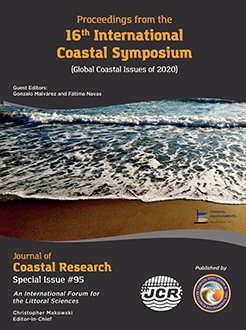Castelle, B.; Scott, T.; Brander, R.W.; McCarroll, R.J.; Tellier, E.; de Korte, E.; Tackuy, L.; Robinet, A.; Simonnet, B. and Salmi, L.-R., 2020. Wave and tide controls on rip current activity and drowning incidents in Southwest France. In: Malvárez, G. and Navas, F. (eds.), Global Coastal Issues of 2020. Journal of Coastal Research, Special Issue No. 95, pp. 769–774. Coconut Creek (Florida), ISSN 0749-0208.
The meso-macrotidal sandy surf beaches of southwest France are a popular destination visited by millions of tourists each summer, who potentially expose themselves to surf zone hazards and particularly to rip currents flowing through the inner-bar rip channels. 281 non-fatal and fatal drowning incidents, most of them caused by rip currents, recorded by lifeguards during the summer 2007, 2009 and 2015 were combined with measured and hindcast wave and tide data. Results show that drownings occur disproportionally near neap low tide, under shore-normal incident waves and average to above-average height and period, with drowning incidents tending to occur in clusters with particular days of mass incidents. An XBeach model is implemented on measured rip-channelled bathymetries to address the influence of offshore wave conditions and tidal elevation on rip flow dynamics and resulting hazard. Simulations show that rip flow increases with increasing wave height, increasing wave period and increasingly shore-normal incidence, which is consistent with the increased number of drowning incidents for such conditions. Although more incidents also tend to occur on warm sunny days with light winds, presumably driving more exposure to the rip current hazard, this highlights the dominance of the physical hazard on the life risk along this stretch of coast.





